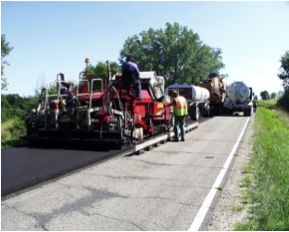 What: A train of equipment mills 3-5” of an existing poor quality pavement, grinds and resizes the reclaimed asphalt pavement (RAP), mixes it with an asphalt emulsion binder, places it back on the pavement, compacts the newly recycled pavement, and leaves an improved base ready for a surface treatment or overlay. Rejuvenator oils, polymers or other additives may be included in the binder for improved performance. Virgin aggregates, flyash, lime or other additives may also be used to improve the mix.
What: A train of equipment mills 3-5” of an existing poor quality pavement, grinds and resizes the reclaimed asphalt pavement (RAP), mixes it with an asphalt emulsion binder, places it back on the pavement, compacts the newly recycled pavement, and leaves an improved base ready for a surface treatment or overlay. Rejuvenator oils, polymers or other additives may be included in the binder for improved performance. Virgin aggregates, flyash, lime or other additives may also be used to improve the mix.
Where: CIR is an effective application on severely distressed pavements on all types of streets and highways, from country roads to interstate highways. The roadway should have a structurally sound base with good drainage. The pavement should be thick enough (typically more than 4”) to leave sufficient existing pavement or base capable of supporting the equipment train. CIR is appropriate for asphalt pavements as well as bituminous layers over PCC on composite pavements. CIR can also be used to upgrade pavements, to meet changing structural requirements and to widen roads.
Why (advantages): Pavements experiencing severe distresses can be rehabilitated; cracks are interrupted; deformations such as potholes, ruts, bumps and shoved pavement are removed and leveled; and flexibility is restored to the aged and brittle pavement. Surface characteristics such as skid resistance are improved, and surface drainage and cross-slope crowns are re-established. Deficiencies in the mix can be corrected with added aggregate and/or asphalt binder. Using in-place materials minimizes hauling and use of virgin materials; clearances under bridges and curb height are retained; and there is an excellent public acceptance of recycled materials.
Why not (disadvantages): The base must be strong enough to support the equipment. Partial depth CIR does not stabilize the base.
When: When a pavement surface has reached the end of its design life, typically 12-25 years old. If the pavement has failed prematurely, the reasons for the pavement failure must be determined so they are not repeated.
Estimated life extension: 4-17 years.
For more information on successful cold recycling, consult the CIR checklist put together by the Foundation and FHWA.
